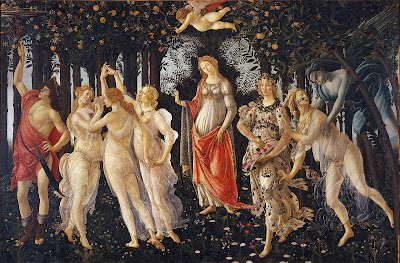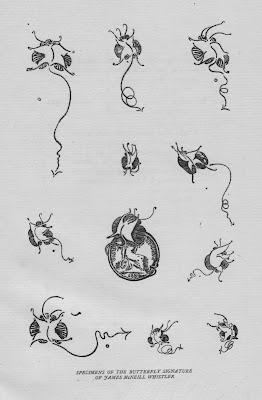Ronald Firbank attended Trinity Hall, Cambridge from 1906-09. At the end of this time he left with some especially cultured friends such as Vyvyan Holland (Oscar Wilde's youngest son) but without sitting a single exam or, seemingly, doing any academic work at all.
There are lots of pictures: the first I spotted was above the sofa: James Whistler's Nocturne: Blue and Gold - Old Battersea Bridge which was painted at the same time as the famous nocturne libelled by John Ruskin (Whistler sued, won, was awarded a farthing damages and was bankrupted.) The mature Whistler always signed his work with a pointed-tailed stinging butterfly, a collection of which I show here, one of which is clearly fucking a farthing!
I am interested here in Firbank's rooms which are described in several reminiscences in Ronald Firbank Memoirs and Critiques (Duckworth 1977.) Vyvyan Holland remembers:
His rooms were filled with unaccustomed things disposed in unusual places. The room was always full of flowers all through the year. Firbank had Conder lithographs and paintings on his walls, and several etchings by Helleu, whom he had known in Paris.
 |
| Drypoint by Paul Cesar Helleu |
 |
| Drypoint by Paul Cesar Helleu |
Ifan Kyrle Fletcher gives further details:
His rooms were arranged with old red silks, masses of flowers, and a number of dainty tables, covered with books and statuettes, and, in a place of honour, a photograph of his mother in Court dress. In this room he would sit in curtained and shaded twilight, behind his head the yellow glimmer of candles set in carved and gilded candelabra.
Bertie Landsberg adds:
I knew him in 1907 when I went to Cambridge ...He was happiest in the curtained and shaded twi-light of his rooms, that were always full of flowers and lit by candles in carved & gilt Italian altar candle-sticks. There he would sit with his back to the light, surrounded by old silks & photographs of his mother in court dress and innumerable little tables covered with books & statuettes (reproductions for the most part of little religious Gothic figures & of Pompeian & Tanagra things).
It was in that same year, 1907, that two photographs of Firbank's Trinity Hall room were taken (from The New Rhythm, and Other Pieces, Duckworth 1962.) it is interesting to compare these photographs with these three similar descriptions.
The first photograph, looking into the room, is inscribed top left:
Trinity Hall
my Room!
07
and the second, taken nearly 90 degrees anticlockwise from the first, looks towards the fireplace and alcove with a curtained window behind. At the top left:
Trinity Hall
and bottom right:
Summer T
the T begins another word, possibly Term, but it is illegible.
Immediately on comparing the two, it can be seen that some items have been moved in between the photographs being taken. The first photograph has a circular table with tablecloth in the centre yet the second has in approximately this position a square table. Looking back to the first photograph, this square table is by the sofa, against the wall. On the sofa are three large cushions which appear in the second photograph by the fireplace in front of an elaborate piano stool which has to be moved back to accommodate the cushions. Of course there is little overlap between the photographs but the piano, or part of it, appears in both and a female bust on top of a few books on the right hand corner of it is missing in the second photograph.
Looking at the room itself, whilst a visible window has a long heavy curtain, the room is illuminated by natural light from an uncurtained window behind the photographer. Undoubtedly, as described, there are plenty of plants and flowers: ferns in the fireplace, more with hanging plants on the mantelpiece and vases of flowers across the room on almost every flat surface.
 | |
| James Whistler by Helleu |
 | |
| Old Battersea Bridge by Whistler |
There are lots of pictures: the first I spotted was above the sofa: James Whistler's Nocturne: Blue and Gold - Old Battersea Bridge which was painted at the same time as the famous nocturne libelled by John Ruskin (Whistler sued, won, was awarded a farthing damages and was bankrupted.) The mature Whistler always signed his work with a pointed-tailed stinging butterfly, a collection of which I show here, one of which is clearly fucking a farthing!
On the circular table in the first photograph is the amazing photograph of Firbank's mother in full court dress. There look to be others here and there.
In the first photograph there appear to be Helleu pictures, looking very similar to his dry points, right of the sofa, on the wall opposite us and, in the second, on top of the piano. Paul Cesar Helleau was an artist best known for his portraits of beautiful society women of the Belle Époque and Firbank's attraction is obvious. Along the piano is a print of Botticelli's Primavera. Botticelli had been lost in history but rediscovered and revered by the Pre Raphaelites - Rossetti was a fan and Burne Jones took a large slab of his aesthetics from the rediscovered paintings. The Primavera was, and is, revered as one of Botticelli's greatest works, yet holding mysterious symbolism interpreted by many including Herbert Horne, aesthete, connoisseur, expert on Botticelli and friend of Wilde.
 |
| Botticelli's Pimavera |
Evidence for the Conders is difficult to find but there is a fan above the Whistler and Conder was famous for his painted fans. The other ornaments and silks are invisible, even the Tanagara figures beloved of Wilde. There are shaded candles on the mantelpiece, though they are not in carved, gilt candelabra, but we can imagine Ronald Firbank in this room, twisted together and writhing on the piano stool, in silhouette, behind him the yellow glimmer of candlelight as he speaks in his high, nervous voice:
He seldom directed the conversation, but added to its piquancy by a well-timed anecdote. Frequently his stories were unfinished. Either his mind would fly off at a tangent, leaving his listeners to bridge the gap, or he would lose his climax in torrents of hoarse, helpless laughter.




No comments:
Post a Comment